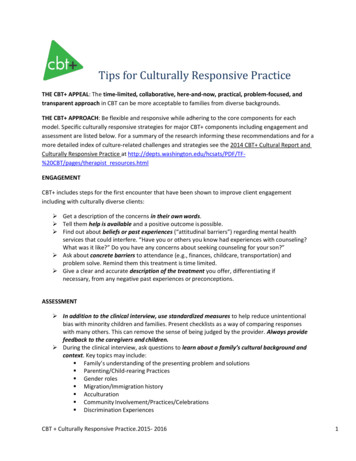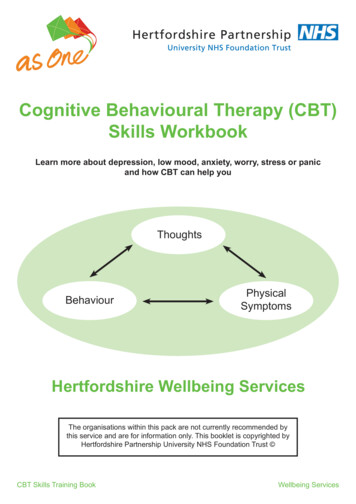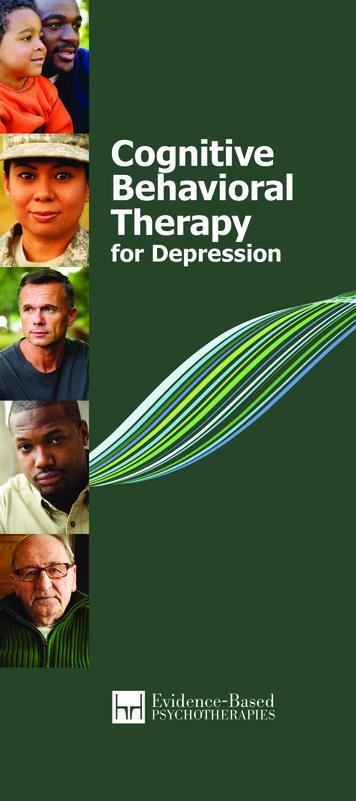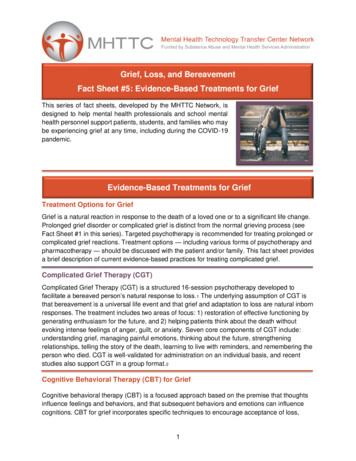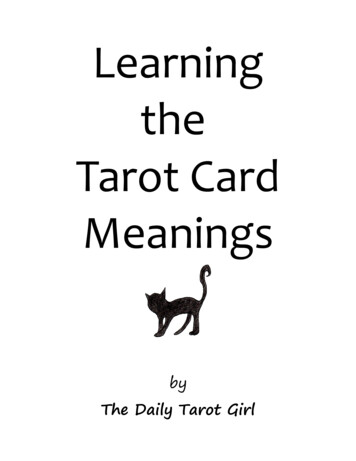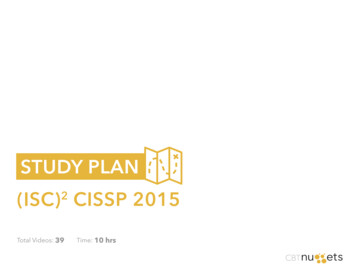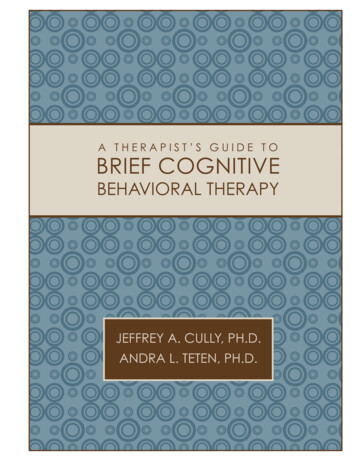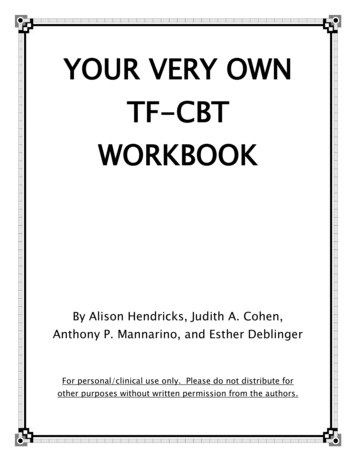
Transcription
YOUR VERY OWNTF-CBTWORKBOOKBy Alison Hendricks, Judith A. Cohen,Anthony P. Mannarino, and Esther DeblingerFor personal/clinical use only. Please do not distribute forother purposes without written permission from the authors.
YOUR VERY OWN TF-CBT WORKBOOKTABLE OF CONTENTSINTRODUCTION3-4WELCOME TO THERAPY!ABOUT YOUABOUT YOUR FAMILYLEARNING ABOUT UPSETTING/CONFUSING EVENTSHOW DO KIDS FEEL AFTER AN UPSETTING/CONFUSINGEVENT?WHAT IS RELAXATION?HOMEWORK: LET’S RELAX !BELLY BREATHINGYOUR SAFE PLACEABOUT FEELINGSHOW DO WE EXPERIENCE FEELINGS IN OUR BODIES?HOW DO FEELINGS SHOW ON FACES?HOW STRONG OR INTENSE ARE OUR FEELINGS?COPING WITH UPSETTING FEELINGSFEELINGS SURVIVAL KITSTOP THAT THOUGHT!THOUGHTS, FEELINGS, AND ACTION!THOUGHTS MATTER!THOUGHT PROBLEMSNOTICE YOUR THOUGHTS!TELLING YOUR STORYYOUR STORYFEELINGS 1-10YOUR THOUGHTS AND FEELINGS ABOUT THEUPSETTING/CONFUSING EVENT(S)BATTLING TRAUMA REMINDERSSHARING YOUR STORYBEING SAFEYOUR CIRCLE OF SAFETYYOUR FABULOUS FUTURELET’S REVIEWSAYING 2829303132333435
Your Very Own TF-CBT WorkbookIntroductionThis workbook has been developed for use with children ages six to fourteen who haveexperienced one or more traumatic events. The activities in the workbook correspond tothe treatment components of the Trauma-Focused Cognitive Behavioral Therapy (TFCBT) model, which was developed by Judith Cohen, Anthony Mannarino, and EstherDeblinger (Cohen, Mannarino, & Deblinger, 2006). The intended use of the workbook isby master’s level mental health professionals who have also had training in TF-CBT andhave read the manual on TF-CBT (cited above).The workbook was created as a supplemental resource to assist therapists as they workthrough each component of the TF-CBT model with their child clients. This workbook isone of the many resources that therapists can use in implementing TF-CBT, and themanual cited above provides and extensive list of books, activities, and other therapeuticaids. The workbook intends to provide a helpful framework to cover each component ofTF-CBT, but other resources and activities should also be utilized as clinically indicated(i.e. play therapy, role plays, movement therapy, audio relaxation exercises, therapeuticboard games, etc). Get creative! As always, clinical judgment takes precedence. Someof the activities included in the workbook may not be appropriate for all children, andflexibility needs to be balanced with fidelity to the treatment model.The workbook activities were developed for implementing the PRACTICE componentsof the TF-CBT model: Psycho-education, Relaxation, Affective regulation andmodulation, Cognitive coping and processing, Trauma narrative and cognitive processingof the traumatic experience(s), In vivo mastery of trauma reminders, Conjoint sessions,and Enhancing future safety and development. The child and parent will initially needsome orientation to TF-CBT, and issues of confidentiality and sharing of the child’s workneed to be discussed from the outset. The workbook can be completed over the course of12-20 weeks, depending on the length of each session and the age/attention span of thechild. Keep in mind that some traumatized children may require other types of treatmentbefore, during, or after TF-CBT. The workbook activities correspond to the componentsof the TF-CBT model as follows:Orientation to Therapy and TF-CBT, EngagementPsycho-education on Trauma and Reactions to TraumaRelaxation: Progressive Muscle Relaxation, Deep Breathing, PositiveImageryFeelings IdentificationFeelings Ratings and Affect ModulationThought StoppingCognitive ProcessingCreating the Trauma NarrativeProcessing the Traumatic Experience(s)3Pages 5-7Pages 8-9Pages 10-13Pages 14-16Pages 17-19Page 20Pages 21-24Pages 25-27Page 28
In Vivo Mastery of Trauma RemindersConjoint Sessions – Sharing the Trauma NarrativeEnhancing Future Safety and DevelopmentGoals, Review, GraduationPage 29Page 30Pages 31-32Pages 33-35Following the structure of the TF-CBT model, the therapist meets individually with childeach week to complete the above (and other supplemental) treatment activities. Then thetherapist meets with the parent individually to work with the caretaker on the samecomponent, to teach him/her the skills to support the child at home and for the caretakerto process his/her own feelings about the trauma. Sharing the activities completed by thechild in the workbook each week can be a helpful way to work with the parent on thetreatment components, in addition to supplemental resources geared toward parents.Parents usually appreciate seeing their children’s artwork and writing, and sharing theseprovides the opportunity for the therapist to increase the parent’s empathy andunderstanding of the child’s experience. The children also generally like the fact thattheir parents will get to see their work. Again, use your clinical judgment if the childdoes not want you to share a particular page with a parent right away or if sharing iscontra-indicated in any way. Some games or activities may be used during conjointsessions in which the child and parent can practice and share together. For example,children may enjoy teaching their caretaker the Belly Breathing games (Page 8) or theFeelings Charades game (Page 12) and playing together in session. It is important tohave caretakers involved in the safety component (Pages 27-28). Again, flexibility isimportant!Homework activities can be assigned each week for the child, caretaker, or dyad at thediscretion of the therapist. The workbook includes a relaxation activity that is labeled ashomework (it can also be taught or practiced in session) and recommends daily practiceof the deep breathing techniques. You may create games for the dyad to play ashomework, assign thought logs, etc. Use your imagination, and tap into the individualchild’s strengths and interests when planning your interventions.For further information on TF-CBT and its components, please refer to the treatmentmanual:Cohen, J.A., Mannarino, A.P., & Deblinger, E. (2006). Treating trauma and traumaticgrief in children and adolescents. New York: Guilford Press.An additional resource is the on-line TF-CBT training at: http://tfcbt.musc.edu/ .4
WELCOME TO THERAPY!Therapy is a safe place to help you feel better about upsettingor confusing events that you have experienced. You will get todraw, write, talk, and play!You will learn many importantthings about: upsetting/confusing events, feelings, relaxation,and how to stay safe. You will also learn a lot about yourself:your thoughts, feelings, actions, strengths, and dreams!Please draw a picture to show how you feel about being heretoday:Do you have any questions about therapy?5
ABOUT YOUYou are a very special person! There are many special thingsabout you and a lot of things you are good at. Please draw orwrite some of these things:What are some things you like to do for fun?6
ABOUT YOUR FAMILYWhat are some things you like about your family? What do you andyour family like to do together? Please draw or write some of thesethings:7
LEARNING ABOUT UPSETTING/CONFUSING EVENTSUpsetting/confusing events are also called traumas.These events don’thappen often, but when they do, they can cause people to feel very afraid,upset, and helpless. There are different kinds of upsetting/confusing events.Let’s learn about the upsetting/confusing event(s) that you experienced. Yourtherapist will help you find the answers to some common questions kids haveabout upsetting/confusing events.(If you have experienced more than onetype of upsetting/confusing event, you can repeat the questions for each one).What is it called?What does that mean?Who does this happen to?Are there a lot of kids who experience this?Why does this happen?What can kids do if this happens to them?Create your own questions here:1.2.3.4.8
HOW DO KIDS FEEL AFTER AN UPSETTING/CONFUSINGEVENT?Many kids have scary memories or dreams about the upsetting/confusingevent.Some kids also feel jumpy or nervous or angry.After anupsetting/confusing event, a lot of kids watch out for danger and worryabout bad things happening. Some kids also have trouble sleeping andpaying attention in school. A lot of kids feel like they DON’T want to talkabout or think about the upsetting/confusing thing that happened, butthe memories pop into their minds anyway.When something remindsthem of the upsetting/confusing event, kids may feel upset and may havestrong reactions in their bodies (heart beating fast, stomach ache).Please circle any of the things above that you have experienced since theupsetting/confusing event(s). Then draw or write below what kinds offeelings you think kids have after these kinds of events:What can kids do about these feelings?9
WHAT IS RELAXATION?Relaxation is about feeling calm and peaceful. After upsetting/confusingevents happen, we often feel tense, jumpy, and worried. We feel betterwhen we learn to relax our bodies and minds! This exercise teaches ushow to relax using our muscles:Sit comfortably in your chair with your arms at your sides and your feet planted on thefloor. Close your eyes or look down at the ground while you do this exercise. Imaginethat you have a ball of clay in your right hand. Squeeze that ball of clay as hard as youcan! While you are squeezing, feel how tight the muscles of your hand and arm are.Count to five as you squeeze, then drop the ball of clay and let your hand hang loose.Feel the difference in the muscles of your hand and arm when they are relaxed. Repeatto yourself, “My hand is relaxed.” Now do the same thing with your left hand. You cando this with all the parts of your body one at a time or all at the same time (yourtherapist will help you)! Which way would you like to do it? Don’t forget to include allyour muscle groups (arms, feet, legs, stomach, back, chest, shoulders, face).Please draw two pictures of yourself below:Tense/Tight/StressedRelaxedWhat are some things you do that help you feel relaxed?10
HOMEWORK: LET’S RELAX!Many kids have trouble calming down or falling asleep at night.If this ever happens to you, practice this activity at home.Someone special can read it to you before bedtime or anyother time when you want to relax.Lie down or sit comfortably somewhere quiet and cozy (yourbed, a couch). Breathe in slowly and out even more slowly.Close your eyes and imagine you are floating on a soft, fluffycloud. You feel very safe on your cloud as it cradles your bodylike a hammock. Your whole body feels very relaxed andheavy. Notice your feet. Your feet feel very relaxed. Your feetfeel so heavy that it would be hard to lift them if you tried.Now notice your legs. Your legs feel very relaxed. Your legsfeel so comfortable all nestled into your cloud. That nice,warm, relaxed feeling is slowly traveling up your body, filling itwith peace. Notice your stomach. It feels very calm and filledwith a pleasant warmth. Now be aware of your chest. Yourchest feels relaxed as it moves up and down slowly with eachbreath. Notice your neck and shoulders. They feel so tranquiland heavy. Feel the backs of your shoulders touching thecloud below you, sinking in gently. Feel how relaxed yourhead is right now. It feels very warm, pleasant, and heavy.Your head and face are very relaxed. Your mouth and eyes arefree of stress. Allow your thoughts to come and go withoutworrying about anything. Everything is okay, and you arefeeling very calm and good. Enjoy the warm, calmingsensation as it travels all around your body, filling you withpeace and relaxation.11
BELLY BREATHINGSometimes when we are upset, we forget to breathe! Or wetake short, shallow breaths (like a puppy dog panting) thatdon’t give our bodies the oxygen we need. To help ourselvesfeel relaxed and calm, we can practice BELLY BREATHING!Belly breathing is when you breathe in slowly and deeply(counting to 5 in your head) as your belly and lungs fill up withair (you can watch your belly stick out as you breathe in!).Then you let the air out, EVEN SLOWER (count to 6) and watchyour belly go back in as the air is slowly pushed out. Payattention to the air as it moves in and out of your body as youcount.Fun games with belly breathing:1. Use Belly Breathing Balloons to show how your belly fills up with air asyou breathe in and goes down when you push the air out.Have yourtherapist blow up one of the balloons as you breathe in, then slowly letair out of the balloon as you breathe out.Watch the Belly BreathingBalloon as it gets bigger and smaller, just like your belly when you aredoing belly breathing!Then switch!YOU make your own balloon getbigger and smaller as your therapist breathes in and out (slowly!).2. Decorate your Belly Breathing Balloon any way you want. Then lie onyour back on the floor or lean back in your chair and place the balloon onyour belly. Watch your Belly Breathing Balloon rise up on your belly like ahot air balloon as you breathe in and land gently as you breathe out.Your therapist can do this with you if you want.Teach these games to someone you care about and practice athome (at least once a day)!12
YOUR SAFE PLACEPlease close your eyes (or look down) and take a few minutes to thinkabout a place (real or imaginary) where you feel very safe, calm, andhappy. You can tell your therapist once you have your safe place in mind.Now draw a picture of your safe place below. Add as many details as youcan to show what you see, hear, smell, taste, and feel when you are inyour safe place.Wonderful! You can close your eyes and imagine you are in your safeplace when you feel scared or tense. When you think about your safeplace, remember all the details that you drew in this picture!13
ABOUT FEELINGSFeelings are what we feel in our bodies and hearts. There aremany different feelings that we have, and our feelings maychange from moment to moment. Sometimes we even feel twoor more feelings at the same time!Please write down as many feelings as you can think of belowon the left side of this paper:Great! Now put a color next to each feeling to describe thefeeling.14
HOW DO WE EXPERIENCE FEELINGS IN OUR BODIES?Remember the feelings and colors you listed on Page 6? We’re going touse those colors now to show where in your body you experience eachfeeling. You don’t have to do all the feelings you listed; you and yourtherapist can choose which feelings you want to include. For each feelingyou choose, close your eyes and imagine having that feeling right now.Where do you experience that feeling in your body? Please color in theplaces on your body where you experience each feeling and tell yourtherapist what it feels like.Our bodies tell us how we are feeling!15
HOW DO FEELINGS SHOW ON FACES?A good way to tell how we feel and how others feel is by noticing facialexpressions. Please draw the feelings in the circles to show how weexpress our feelings on our faces (the last two are blank for you to drawany feelings you kedbraveproudHow do you feel right now? You can play a game with your therapist called“Feelings Charades.” Take turns acting out the above feelings; the other persontries to guess which feeling you are acting out! Then you get to tell what makesyou feel that way. You can also play this game at home.16
HOW STRONG OR INTENSE ARE OUR FEELINGS?Sometimes we feel a feeling just a little bit, and other times we feel afeeling so strongly that we feel like we mightBURST with that feeling!You can rate or measure your feelings, just like a thermometer measurestemperature. The number tells how intense the feeling is.10VERY STRONG98A LOT765MEDIUM432A LITTLE10NOT AT ALLWhat feelings are you having right now? How would you rateeach of those feelings (on a scale of 1-10)?17
COPING WITH UPSETTING FEELINGSWhen we experience an upsetting feeling very strongly, we canDO THINGS to lessen the intensity of the feeling. For example,if your anger is at a 10 (very strong), you can do things tobring it down to a 1 or 2. What are some of these things youcan do?Please draw a picture of you doing something thatwould help bring your anger down:YOU’RE IN CHARGE OF YOUR FEELINGS!18
FEELINGS SURVIVAL KITWhen you feel very sad, scared, mad, or worried, what aresome things you can do to feel better? What are some thingsyou can tell yourself that would make you feel better? Pleasemake a list of things you can do and say to feel better:Congratulations! You have just made your own personalFeelings Survival Kit . You can cut out the items from yourlist and place them in a special box, bag, or toolkit. Take itwith you so that the next time you feel very upset you willremember what to do!19
STOP THAT THOUGHT!Sometimes we think about bad things over and over (like a song youdon’t like that gets stuck in your head). We’ll call this a bad song,because it can make us feel really bad! But guess what? You can stopthat bad song! All you have to do is notice when that bad song plays inyour head. As soon as you hear it, press STOP! You can also say, “Goaway, bad song!” And then you can sing yourself a happy song (onethat makes you feel good)!How does your bad song go? You can write or draw your bad song here:How does your happy song go? Write some of the words or draw apicture of your happy song here:Let’s practice! Sing your bad song right now in your head. When I saySTOP, start singing your happy song instead. Now you can decide whento press STOP on your bad song and PLAY your happy song!20
THOUGHTS, FEELINGS, AND ACTION!What are thoughts? Thoughts are the ideas we have in our heads (whatour brains tell us). Sometimes we say things to ourselves in our heads(not out loud), and these are also thoughts.For example, you mightthink, “I did a great job on my homework.” Can you think of some otherthoughts?What are feelings? Feelings are the emotions and sensations we have inour bodies and hearts (you already know a lot about feelings!). What aresome feelings you know about?What are actions? Actions are the things we do with our bodies!Forexample, we walk, dance, talk, draw, laugh, cry, etc. Can you name someother actions?Thoughts, Feelings, and Actions GameThis is a game to help you learn the difference between thoughts,feelings, and actions. Put a blue X the items that are thoughts. Put agreen X next to the items that are feelings. Put a red X next to items thatare actions.HAPPYSINGINGRUNNINGLONELYI’M SMART!SHE’S MAD AT MEHITTINGEATING ICE CREAMTHEY DON’T LIKE METAKING A WALKSADEXCITEDPLAYINGI’LL BE OKMADSCAREDI CAN DO IT!TAKING A DEEP BREATHIT’S MY FAULTHOPPING ON ONE FOOTWORRIEDBRAVEHIDINGTALKING TO A FRIENDCRYINGSAFE21
THOUGHTS MATTER!Our thoughts affect the way we feel and how we act. When somethinghappens, we form thoughts about the event that lead to feelings andactions. The way we talk to ourselves in our heads also affects how wefeel and what we do.ThoughtsBehaviorFeelingsWhat are the characters below thinking?How do their thoughts makethem ng:22
THOUGHT PROBLEMSSometimes we all have thoughts that either aren’t true or don’t help us tofeel better or solve problems. Some of these thought problems involvethinking that everything has to be all or nothing (i.e. “One person madefun of me, so that means everyone hates me”). Other thought problemsfocus on the worst possible outcome (i.e. “If my mom goes out, I’m suresomething terrible is going to happen to her”). We sometimes get stuckin negative thinking (i.e. “Nothing ever works out for me” or “I’ll neverfeel OK again”). Please write or draw some problem thoughts that you’vehad recently.How did these thoughts make you feel?23
NOTICE YOUR THOUGHTS!When you feel bad, what are you saying to yourself in your head? It’sprobably the thought that’s making you feel bad. But guess what? If youpractice, you can change your thoughts! Try doing this below. First writea thought that makes you feel bad and write down the feeling it causes.Then write a different thought that would make you feel better and writedown the new feeling.What actions might you take in the first situation? What about in thesecond situation? Do these actions lead to different results? Whichresults work out better for you?24
TELLING YOUR STORYYou’ve learned a lot so far about upsetting/confusing events, feelings,coping, relaxation, and thoughts. Congratulations! These are allimportant things that will help you as you begin to tell about theupsetting/confusing event(s) that happened to you. You get to decidewhere you want to start and how you would like to tell your story (youand your therapist can talk about all the different ways for kids to telltheir stories). As you’re telling about what happened to you, yourtherapist will help you check in on your feelings (using the “Feelings 1-10” worksheet on Page 23). If you start feeling strongly upset, you canstop, and your therapist will help remind you of ways to manage yourfeelings. You’re in charge! Please draw or write below to describe howyou feel about starting your story.25
YOUR STORYNow it’s time for you to decide how you would like to tell your story.Some kids like to make their own book, while other kids like to expresswhat happened to them using poetry, songs, cartoon strips, puppetshows, radio/talk shows, etc. You and your therapist can talk aboutcreative ways to tell about the upsetting/confusing thing(s) thathappened to you. You get to decide what form you want your story totake. Don’t forget to use the “Feelings 1-10” worksheet (on the nextpage) for each session!The title of my story is:This is how I will create my story:26
FEELINGS 1-10Remember when you used the thermometer to measure your feelingsback on Page 9? Each time you meet with your therapist to tell yourstory, you will name and rate your feelings at the beginning, middle, andend of the session on this paper (make 1 copy of this worksheet for everytrauma story session). Please rate your feelings on a scale of 1-10 todescribe the intensity of the feeling (1 a little bit, 5 medium, 10 verystrong, etc.). You and your therapist will then come up with a plan tohelp you manage any difficult feelings that may come up betweensessions (don’t forget to use your Feelings Survival Kit !).Date:StatusFeeling(s)Beginning of SessionMiddle of SessionEnd of SessionSelf-Care Plan:27Rating
YOUR THOUGHTS AND FEELINGS ABOUT THEUPSETTING/CONFUSING EVENT(S)Remember how we learned that our thoughts are important? Your thoughts related tothe trauma affect how you feel. These thoughts can help you feel better more quickly,or they can keep you feeling upset. Let’s look at some of your thoughts related to thetrauma. Below is a list of questions and thoughts that kids often have after anupsetting/confusing event. You and your therapist can choose which questions you willdiscuss, and you can add your own questions or thoughts at the end of the list. Then,for each question, you can write down the answer that is most helpful.1. Why did this happen to me?2. Who is responsible for the upsetting/confusing event(s)?3. How will the upsetting/confusing event(s) affect me in the future?4. How have the upsetting/confusing events affected my family?5. Since the event(s), my view of the world has changed in these ways:6. Since the event(s), my view of myself has changed in these ways:7. Since coming to therapy, I have learned these things about myself:8. Coming to therapy has changed me and my family in these ways:7. If I had a friend that went through a similar upsetting/confusing event, Iwould give him or her this advice:9. If my friend thought that talking about the upsetting/confusing eventwould be too hard, I would tell him or her:10.11.12.28
BATTLING TRAUMA REMINDERSNow that you have bravely told your story and talked about your thoughtsand feelings, let’s talk about trauma reminders. Trauma reminders arethings that remind you about the upsetting/confusing event(s). They caninclude certain places, people, words, sounds, smells, sensations, etc.When you experience these reminders, you may feel unsafe or as if youwere living through the upsetting/confusing event(s) over again. But youcan use your coping and relaxation skills to gain control over these peskyreminders! Please draw or write a few of your trauma reminders below.Now you and your therapist will come up with a battle plan to conquereach trauma reminder, one by one. Then you can practice in session togain control over these trauma reminders in your life!29
SHARING YOUR STORYGreat job! You did it! You have been very brave in telling your story andtalking about your thoughts and feelings. It can help to share your storyor to talk about the trauma(s) with someone you trust. How would youfeel about sharing your story with a special someone? Please draw apicture or write about sharing your story or talking about theupsetting/confusing event(s) with your special person.What are some questions you would like to ask your special person? These canbe questions you have about the upsetting/confusing event(s) or a quiz to testhow much your special person remembers (about your story, what you havelearned in therapy, etc.).1.2.3.4.30
BEING SAFEWe do a lot of things every day to keep ourselves safe. What are somenew things you’ve learned about safety since coming to therapy? Pleasedraw a picture of you doing something to keep yourself safe.What are some things other people can do to help keep you safe?1.2.3.4.5.31
YOUR CIRCLE OF SAFETYThere are a lot of people who care about you and your safety. These arepeople you can go to if you need help or if you want someone to talk to.Please draw a picture of yourself on the middle of this page. Then createyour circle of safety by drawing and/or writing the names of all thepeople who help keep you safe around you. You can include their phonenumbers, too!32
YOUR FABULOUS FUTUREWhat hopes, dreams, and goals do you have for your future?Please draw or write some of them in the space below.You can achieve anything you set your mind to!33
LET’S REVIEWWhat have you learned in therapy? What was your favoritepart? What was your least favorite part? Please write or draw apicture to show a special memory or lesson you want to takewith you from therapy.34
SAYING GOOD-BYEHow do you feel about saying good-bye? How do you feelabout graduating? You can use this final page to show all thefeelings you’re having right now, using words, art, etc., OR youcan draw a picture of you and your therapist saying good-bye.Congratulations on all your hard work! You did it! Youfinished your book!35
manual cited above provides and extensive list of books, activities, and other therapeutic aids. The workbook intends to provide a helpful framework to cover each component of TF-CBT, but other resources and a
